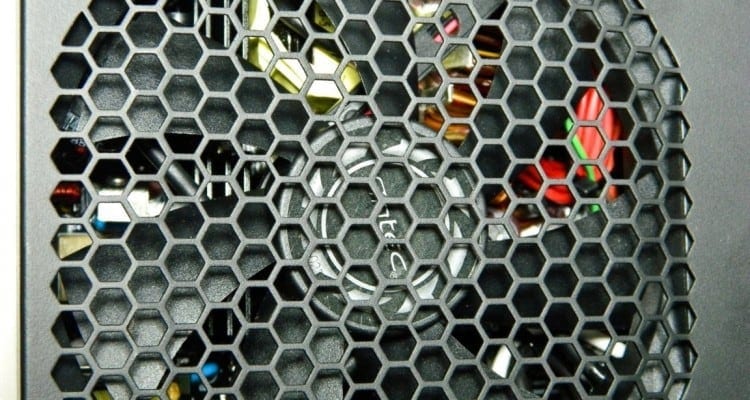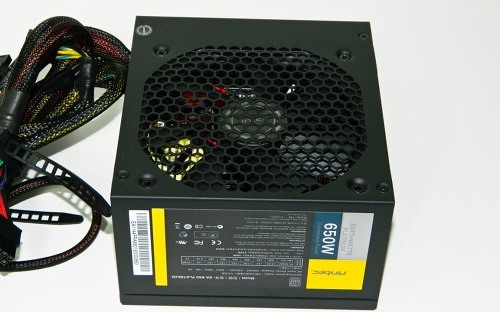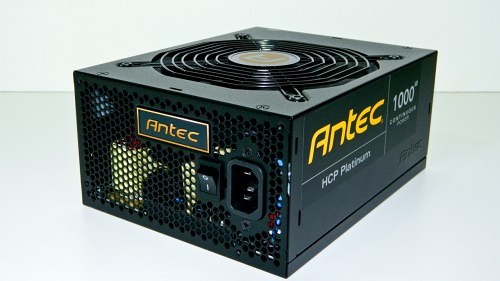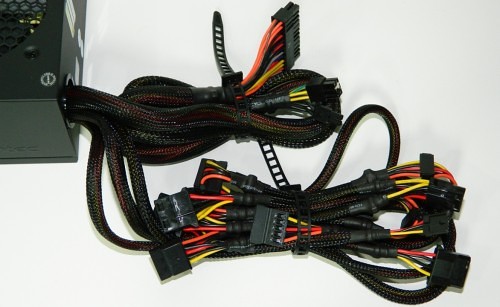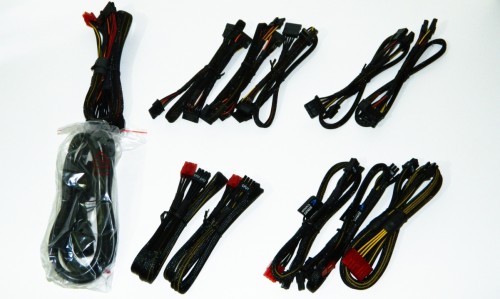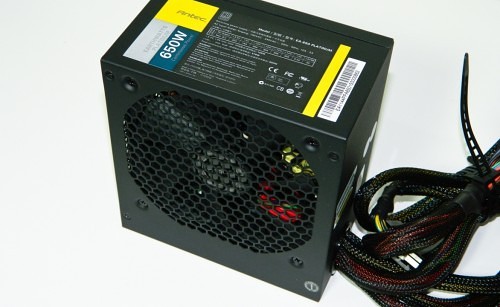Quality Control – What Makes Them Tick!
Inside the EA-650, the smaller supporting capacitors are Nippon Chemi-con and the main 390uF 420V capacitor is made by CapXon. CapXon caps are made in China and don’t fair well in very hot environments despite their 105C operative max temp rating. However, if you keep CapXon caps cool with decent airflow, they tend to last longer. Perhaps this explains why the fab used a Yate Loon case fan for cooling which are know to be very good.
The EarthWatt’s specs don’t disclose any fan specifications. The fan’s label indicates it’s a Yate Loon D12BH-12 which is indeed a case fan. Comparing the model number online, the 120mm fan is rated up to 41 dB moving about 89 cubic feet of air a minute. While this may seem like overkill, it needs to keep the MOSFETs, switching and caps as cool as possible.
Inside the HPC-1000, four heat sinks keep the mission sensitive MOSFETs cool. However, this unit has nicer switching components and two Nippon 450V – 470uF capacitors which are more resilient than CapXon. The combined 940uF helps provide much needed power with a PFC controller making sure its rated efficiency is maintained. In simpler terms, the right combination of switching, MOSFETs, capacitors and controller have been assembled to ensure Platinum efficiency.
The HPC series uses a single 135mm cooling fan. I couldn’t find exact specifications for the fan which is made by Delta but the best educated guess is it probably produces just around 100 CFM without breaking 1600 RPMs. Delta fans tend to be found in a lot of pro equipment and are usually quite loud. The odd size will hinder users from easily finding a replacement should the fan fail “after” the warranty expires. Otherwise, Antec is happy to support if something goes wrong.
Connectors Examined and Compared
Both PSU’s cables are braided with what appears to be standard nylon with heat shrink wrap at the ends. Each cable is relatively pliable and won’t rub off any vital epidermal layers when handling. All of the wiring felt pretty well secured to the connectors.
The EA-650’s MOLEX, SATA and PCIE cable lengths are 32 to 40 inches which is enough for mid tower cases if you want to do a little creative routing. However, the 4×4-pin EPS and main ATX main cables are 22 and 24 inches. The EPS isn’t quite long enough to route behind motherboard trays in mid tower or full tower cases with wire management. The 24-pin will probably just make it depending on your board placement. You may have to pick up some cable extensions like the NZXT. ones we reviewed.
The HCP-1000 MOLEX, SATA and PCIE are all about the same length as the EA-650 PSU. However, the 4×4-pin and 8-pin EPS cables are also about 30 inches which better supports good cable management. The main 24-pin length is about 26 inches which is fine given the number of cases with grommet holes for routing.
If you’re wondering how the cabling and PSU sockets fit, it’s spot on perfect. The cabling fits very tightly in to the PSUs sockets with absolutely no play, or wiggle room. You won’t have to worry about them slipping out some how. But, you will have to put some finger power in when removing them.
Test System Setup
The test system we use is to mainly to ensure the power supply can provide power and efficiency up to max output specs. The motherboard software and HWMonitor Pro come in handy for looking to see what kinds of power rail voltage it sees from an end user’s perspective.
Common Components:
- Processor: Core i7-3960X Sandy Bridge-E
- Motherboard: ASUS P9X79-V PRO
- Memory: Kingston HyperX 16GB 1600MHz DDR3
- Storage: Kingston HyperX 120GB SSD
- Enclosure: NZXT. Switch 810 (White)
Variables:
- EA-650 used two ZOTAC GTX 560 Ti SLI
- HPC-1000 used two ZOTAC GTX 580 SLI
From a tech’s perspective, an o-scope answers the question of whether ripple and efficiency are up to specs listed on the label. A load circuit was used to check max output limits and to make sure protective measures built into the power supply unit actually work. The last detail was keeping track of the highs and lows on each power rail while the PSUs are fully tested.

